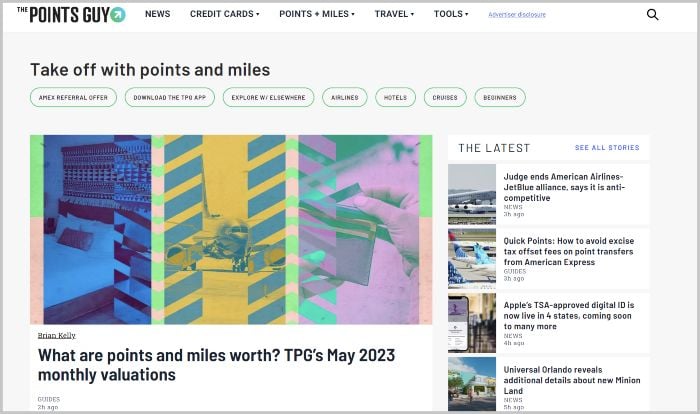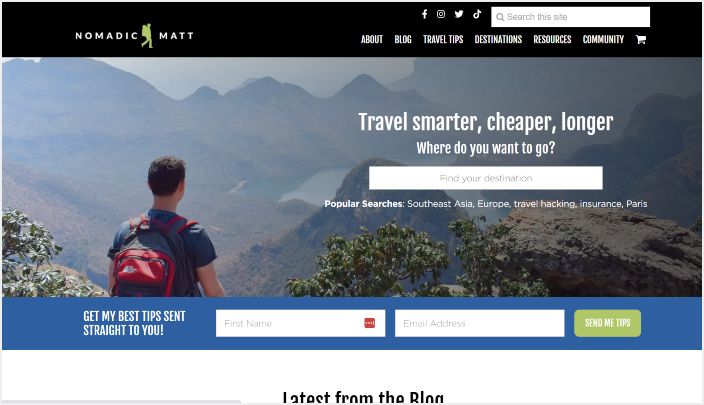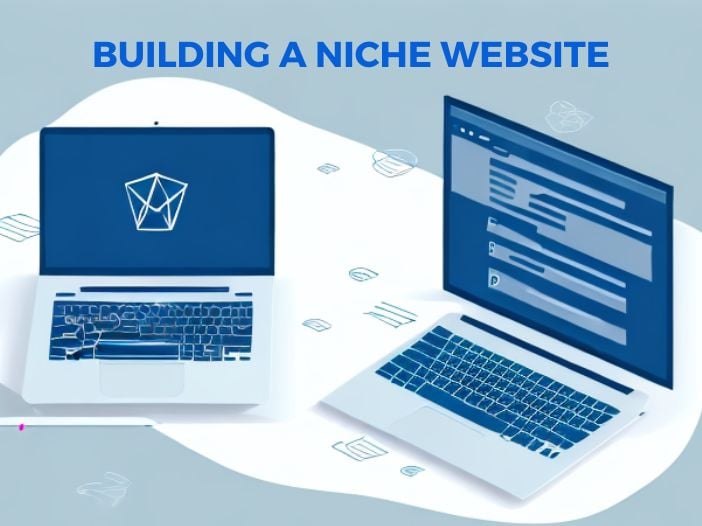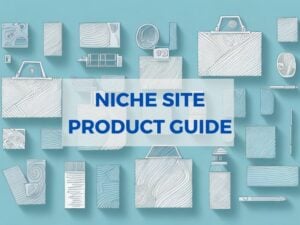Are you looking to build a website that earns cash flow month after month?
Then a niche website may be the way to go.
In this guide, I’ll take you through the process I use to build a niche website step-by-step.
From understanding the concept of niche websites to setting up and customizing your website to creating high-quality content and monetizing your efforts, I’ve got you covered. So, let’s dive right in.
Understanding Niche Websites
What is a Niche Website?
A niche website is a site that focuses on a specific, narrow section of the market. This provides an opportunity to target a particular set of consumers with unique needs or interests that a broader website might not address.
A niche website aims to provide tailored content and solutions to its target audience, resulting in high engagement and customer loyalty.
For instance, a website that focuses on providing information about pet care for senior dogs is a niche website, as it caters to a specific audience with a particular interest or need.
Similarly, a website that offers advice and resources for new mothers is another example of a niche website.
Benefits of Building a Niche Website
Building a niche website can offer many benefits.
Firstly, it allows you to focus your content and services on a specific market segment, which helps build an engaged and loyal audience.
When you cater to an audience’s specific needs, you can create a sense of community and trust, leading to increased traffic and revenue.
Secondly, niche websites are more likely to rank well in search engines because of their focused content.
When you create content specific to your niche, you can target long-tail keywords that are more likely to rank well in search results.
This helps in gaining organic traffic from search engines.
Thirdly, niche websites have little competition compared to broader websites, which means you can likely easily dominate your particular niche.
When you focus on a specific market segment, you can create unique content and services that set you apart from your competitors.
This helps you establish yourself as a trusted authority in your niche and gain a competitive edge.
Lastly, niche websites have excellent potential for monetization through various means.
You can monetize your niche website through affiliate marketing, sponsored content, advertising, and other revenue streams when you have a loyal and engaged audience.
This can help you earn a steady income from your niche website.
Examples of Successful Niche Websites
A great example of a successful niche website is “The Points Guy.”

This website focuses on a specific market segment interested in maximizing their travel rewards and credit card points.
The website features articles and reviews about credit card reward programs, travel gadgets, hotels, and airlines.
The website has over ten million monthly page views, indicating its effectiveness in serving its niche audience.
Another example of a successful niche website is “Nomadic Matt.”

This website caters to a specific market segment interested in budget travel and provides tips and resources for traveling on a budget.
The website features articles on budget travel destinations, travel hacks, and travel guides.
The website has over 1 million monthly page views, indicating its effectiveness in serving its niche audience.
Building a niche website can be a great way to establish yourself as an authority in a particular market segment and earn a steady income.
What Niche Should I Choose?
Are you planning to build a niche website but don’t know where to start?
The first step is to find a niche you’re interested in and can add value to.
Here’s how you figure that out:
Brainstorming Niche Ideas
One way to find a niche is to brainstorm potential ideas.
Think of the areas where you have domain knowledge or expertise.
What are you good at? What do you know a lot about?
Also, look into the topics you’re passionate about and enjoy researching.
What are your hobbies? What are your interests?
For example, if you love cooking a particular kind of food for a particular reason, you could create a niche website about cooking.
Or, if you’re a fitness enthusiast that resolved an ailment through exercise, you could create a niche website about solving that issue.
Blindly selecting a profitable niche you’re not interested in can instantly make the process feel like a tedious chore. So instead, make sure you choose a niche you’re passionate about.
But once you have some options, you must analyze the competition to understand if you have a real chance of success.
Analyzing Market Demand and Competition
Once you have a list of potential niches, it’s time to analyze their market demand and competition.
Determine the size of the market segment and the level of demand for products and services relevant to the niche you’re considering.
For example, if you’re considering a niche website about healthy cooking, you could research the number of people searching for healthy recipes or the number of people looking for cooking tips on social media platforms.
Further, look into the competition in the niche and the current players offering products and services in the area.
Analyze their content strategies, target audience, monetization sources, and any gaps in the market that present opportunities.
Using the healthy cooking example again, you could research the top healthy cooking websites and analyze their content strategies, such as the type of recipes they offer, the format of their content, and the tone of their writing.
You could also analyze their target audience, such as their age, gender, and interests.
By analyzing the competition, you can identify gaps in the market and opportunities to differentiate yourself from your competitors.
You can also understand what’s working so you don’t go too far off the beaten path.
Selecting a Profitable Niche
After analyzing the market demand and competition, finalize the niche with the best potential for success.
Consider your budget, time, and long-term goals to ensure you can sustain the niche website and reach your goals.
For example, if you’re considering a niche website about healthy cooking, you could research the cost of ingredients and the time it takes to create recipes.
Consider your long-term goals, such as whether you want to monetize the website through advertising or selling your products.
Remember, choosing a profitable niche is important, but it’s equally important to choose a niche you’re passionate about and can add value to.
Following these steps, find the perfect niche for your website and build a successful online business.
Planning Your Niche Website
Now that you are ready to create a website that stands out in your niche?
Planning is crucial to the success of your website.
Here are some tips to help you get started:
Setting Clear Goals
Before you start creating content, you must set clear goals for your website.
What do you hope to achieve in the long run? Do you want to generate leads, increase sales, or establish yourself as an authority in your niche?
Understanding the purpose of your website will guide your content strategy, website design, and marketing tactics.
Setting clear goals will also help you measure the success of your website.
You can track your progress and adjust as needed to ensure you’re on the right track.
Creating a Content Strategy
A content strategy is creating and distributing valuable, informative, and engaging content that attracts and retains your target audience.
It’s essential to have a content strategy to guide your website’s content creation efforts.
Your content strategy should align with your goals and target audience.
What type of content will resonate with your audience?
This can include how-to guides, in-depth reviews, listicles, videos, or interviews, to name a few.
Remember, quality over quantity is vital, but you still must create fast enough. I know this may be kind of confusing.
The faster you create quality content, the better. One awesome post a month will be a long hard battle to succeed, whereas a couple of slightly lower-quality posts per week can yield far more results.
Designing a User-Friendly Layout
The design of your website can make or break the visitor experience.
A cluttered or confusing layout can drive visitors away, while a user-friendly layout can keep them engaged.
Design a straightforward, user-friendly layout that complements your niche and allows visitors to find the information they need quickly.
Use clear headings, subheadings, and bullet points to break up text and make it easier to read.
Ensure the layout is mobile-friendly and the website is compatible with different browsers. With more people accessing the internet on their mobile devices, it’s essential to have a responsive design that adapts to different screen sizes.
Following these tips, you can create a niche website that stands out and attracts your target audience.
Remember to stay focused on your goals and create content that provides value to your audience.
Setting Up Your Niche Website
Creating a niche website can be an exciting venture, but it requires a lot of planning and effort.
I have the essential steps you need to set up your niche website successfully.
Choosing a Domain Name
Your domain name is the first thing people will see when they visit your website.
Choosing a domain name that easily reflects your niche and brand image is essential.
A good domain name should be simple, straightforward, and memorable.
It should also be easy to type and pronounce.
When selecting a domain name, consider your target audience and the message you want to convey.
Brainstorm a list of potential domain names and check their availability.
You can use domain name search tools to find available domain names that match your niche.
Selecting a Web Hosting Provider
Once you’ve chosen your domain name, the next step is to select a reliable web hosting provider.
A web host is a company that provides the server space and technology necessary to keep your website up and running.
When selecting a web hosting provider, consider their uptime, security protocols, and support.
You want a web host that can guarantee excellent uptime so your website is always accessible to your audience.
Security protocols are also essential to protect your website from cyber threats.
Finally, ensure that your web host provides reliable customer support in case you encounter any issues, which are likely if you are a first-time niche site builder.
Consider your budget and the website’s requirements when selecting a web hosting provider.
You’ll need to consider factors such as storage, bandwidth, and SSL certificates.
Choose a web host that offers a plan that meets your website’s needs and fits your budget, preferably one that can grow with you over time.
Installing a Content Management System (CMS)
Once you’ve chosen your domain name and web hosting provider, the next step is to install a Content Management System (CMS).
A CMS is a software application that allows you to create, manage, and publish content on your website.
WordPress is an excellent CMS for niche websites as it’s user-friendly, customizable, and SEO-friendly.
With WordPress, you can easily create pages, posts, and menus without any coding knowledge.
You can customize your website’s design and functionality with thousands of free premium themes and plugins.
WordPress is also SEO-friendly, which means it’s optimized for search engines like Google.
You can use plugins like Yoast SEO to optimize your content for search engines and improve your website’s visibility in search results.
By following these essential steps, you can set up your niche website successfully and in a way that can grow with you over time.
Remember to keep your website’s design and content relevant to your niche and target audience.
With dedication and effort, your niche website can become a valuable resource for your audience and a solid source of income for you.
Customizing Your Niche Website
Creating a niche website can be a great way to share your passion with the world and build an online community.
However, creating a website that stands out in a crowded online space can be challenging.
One way to achieve this is by customizing your website to reflect your niche and brand identity.
Here are some tips on customizing your niche website to make it more appealing and engaging to your audience.
Choosing a Website Theme
The theme is the visual appearance of your website.
It is the first thing that visitors notice when they land on your site.
Therefore, choosing a theme that reflects your niche, brand image and conveys the desired message to the target audience is essential.
A visually appealing theme that is easy to navigate can keep visitors on your site for longer. Ensure the theme is responsive, customizable, and optimized for speed.
A slow-loading website can turn off visitors and negatively impact your search engine rankings.
Consider the color scheme, font style, and layout when choosing a theme.
A consistent theme with your branding can reinforce your brand identity and make your website more memorable.
Additionally, a well-designed theme can help to establish your website as a credible and authoritative source of information in your niche.
An old, un-updated-looking website is easily spotted nowadays and should be avoided.
Installing Essential Plugins
Plugins are software applications that add features or functionality to your website.
They can improve the user experience, enhance website security, and optimize your website for search engines.
Essential plugins for a niche website include SEO, backup, social media, and a contact form plugin, among others.
SEO plugins can help to optimize your website for search engines and improve your visibility in search results.
Backup plugins can protect your website from data loss and ensure that your website can be restored quickly in case of a breach.
Social media plugins can help to promote your website on social media platforms and increase your reach.
A contact form plugin can make it easier for visitors to contact you and provide feedback on your website.
Only use plugins that are credible and absolutely necessary starting out.
They can break or slow down your site if you use too many.
Go with the basics of what you need to get started, and once you get better at navigating WordPress, you can slowly add additional features through plugins if necessary.
Creating a Logo and Branding
Your logo and branding are the face of your website and brand.
It is the first thing visitors see when they land on your site, and it can make a lasting impression.
Therefore, designing a logo that reflects your niche and brand identity is essential. Your logo should be unique, memorable, and visually appealing. It should also be scalable to look good on different devices and platforms.
Ensure the branding is consistent throughout the website and social media platforms for better brand recognition.
This helps establish your website as a credible and authoritative source of information in your niche. Consistent branding can also create a sense of trust and familiarity with your audience, leading to increased engagement and loyalty.
Customizing your niche website can make it more appealing and engaging to your target audience.
You can create a website that stands out in a crowded online space by choosing a theme that reflects your niche, installing essential plugins, and creating a logo and branding.
Creating High-Quality Content
Creating high-quality content is essential for any website to attract and retain visitors.
The content on your website should be informative, engaging, and valuable to your target audience.
Here are some tips to help you create high-quality content:
Keyword Research for Niche Websites
Keyword research is a critical aspect of creating high-quality content.
It involves identifying relevant and high-traffic keywords to include in your content.
By using keyword research tools, you can find the ideal keywords to boost your website ranking in search engine result pages.
When conducting keyword research, it’s essential to remember your website’s niche.
You want to target primary and secondary keywords that are relevant to your niche and will attract the right audience to your website.
Writing Engaging and Informative Articles
Writing engaging and informative articles is one of the most important aspects of creating high-quality content.
Your content should educate and entertain your target audience. You should write in a style that complements your niche and brand image.
When writing your articles, it’s vital to ensure the content is plagiarism-free and adheres to the principles of search engine optimization (SEO).
This means using relevant keywords, headers, and meta descriptions in your content.
Adding Visual Elements to Your Content
Images, videos, infographics, and other visual elements add value to your content and make it more shareable.
They can help break up blocks of text and make your content more visually appealing.
When adding visual elements to your content, it’s important to ensure they are original and help convey the desired message to your audience.
You should also optimize your images and videos for search engines using schema, relevant alt tags, and descriptions.
By following these tips, you can create high-quality content that will attract and retain visitors to your website.
Promoting Your Niche Website
When it comes to promoting your niche website, there are several strategies you can use to increase your visibility and attract your target audience.
I’ll explore some of the most effective promotion methods for your niche website.
Search Engine Optimization (SEO) for Niche Websites
One of the most important things you can do to promote your niche website is to optimize it for search engines. SEO is a set of practices to improve your site’s visibility and ranking in search engine result pages (SERPs).
Some crucial SEO tactics for a niche website include optimizing metadata, improving website speed, creating high-quality backlinks, and optimizing your content for long-tail keywords.
Implementing these tactics can improve your website’s visibility and attract more organic traffic from search engines.
Additionally, it’s essential to keep up with the latest SEO trends and best practices to ensure your website stays optimized and competitive in search engine rankings.
Utilizing Social Media Platforms
Social media platforms provide an excellent opportunity to attract and engage your target audience.
However, choosing the social media platforms that align with your niche and target audience is essential.
Develop a social media strategy to create and share valuable content, interact with customers, and build your brand image.
By consistently engaging with your audience on social media, you can build a loyal following and increase your website’s visibility.
Some popular social media platforms for niche websites include Instagram, Pinterest, and LinkedIn.
However, it’s important to research your target audience and choose the most relevant platforms.
Social media can take much time to build, and spending that time on a platform where a small percentage of your audience hangs out is a waste.
Building an Email List
Email marketing is an effective digital marketing strategy for niche websites.
By building an email list, you can keep in touch with your audience and promote your website and products directly.
Offer valuable incentives, such as free ebooks, newsletters, webinars, or discounts, to encourage visitors to sign up for your email list.
Use email marketing software to manage your email lists and send targeted emails to your subscribers.
By consistently providing value to your email subscribers, you can build a loyal following and increase your website’s traffic and conversions.
Promoting your niche website requires a combination of strategies, including SEO, social media, and email marketing.
By implementing these tactics and staying up-to-date with the latest trends and best practices, you can increase your website’s visibility and attract your target audience.
Monetizing Your Niche Website
Affiliate Marketing for Niche Websites
Affiliate marketing is a monetization strategy where you earn a commission to promote products or services on your website.
Join affiliate programs for products or services relevant to your niche and promote them through your content or ads.
Displaying Ads on Your Website
Display ads are a popular way of monetizing niche websites.
Join an ad network like Ezoic, Mediavine, and Google Adsense and display ads on your website.
Ensure the ads are relevant to your niche and advertisers offer significant commissions.
Selling Digital Products or Services
Create and sell digital products and services relevant to your niche audience.
This can include eBooks, courses, webinars, or coaching services, among others. Keep the prices reasonable and offer value for money to your customers.
Flipping Niche Sites
Building niche sites can also work for short-term goals.
Niche sites can sell for as much as 50X your monthly revenue.
If your niche site makes $500 per month, you can sell it anywhere from $17,500 to $25,000, depending on many factors such as website age, niche, and revenue streams.
That’s an excellent ROI for something you can start for less than $100.
Building a niche website can be a profitable and rewarding experience when done right.
Final Thoughts on Niche Website Building
Follow these step-by-step guidelines, and you’re well on your way to building a niche website that caters to your target audience’s needs and interests.
Keep your goals realistic and be prepared to work without seeing any results for a while.
If you remain persistent and show up often, you can find success with your niche site.





